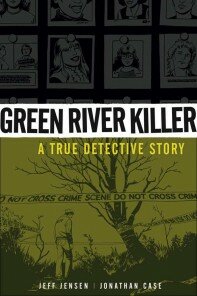 Black-and-white illustrations of course, work by contrasting positive and negative space (I’ll leave you to debate which lies with which). Sharp contrasts come to mind at the phrase “black-and-white” but in reality, infinite shadings are possible.
Black-and-white illustrations of course, work by contrasting positive and negative space (I’ll leave you to debate which lies with which). Sharp contrasts come to mind at the phrase “black-and-white” but in reality, infinite shadings are possible.
And it’s a fair passel of shading we’ll need to approach the story of Gary Leon Ridgway, who needs no further introduction and who just might be the worst serial killer in American history. Although, I’m thinking, beyond “x” number of victims (Ridgway has 49 confirmed, possibly more)–with apologies to the loved ones, no offense meant here–I’m thinking the mind loses its capacity to clearly register each one if it’s asked to. A cut is one cut, and two cuts are two cuts, and three cuts are one, two, and one more…49 cuts is muck.
So it’s through black-and-white strainers–panels–that artist Jonathan Case and writer Jeff Jensen, son of Green River Task Force Tom Jensen, try to push the formless. Through the pages of Green River Killer: A True Detetctive Story (published by Portland’s Dark Horse) a dichotomy takes shape, a yin-yang with two men–Jensen and Ridgway. Their two heads and bodies grow slightly softer over the seasons. Two mustaches–one white, one dark–face each other, mostly with a table between them.
Jensen, in the classic manner of detectives and philosophers, wants answers. Ridgway’s defense is the obfuscation of the squid. He inks the waters, claiming memory has clouded inside him.
Eventually Jensen gets a chance to answer his question and a few others. He doesn’t get a satisfactory answer. I wasn’t expecting him to get one, but then again I’ve read plenty of true-crime books. We can diagnose and we can extrapolate and we can try to agree on appropriate punishments. (And I happen to disagree with the death penalty; Ridgway, of course, cannot die 49 times, which might go some way towards righting his wrongs….) Ultimately, though, we cannot follow down to the core. Those shadings cannot flow from any sane brush.